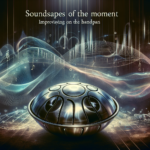The handpan is a relatively new entrant in the world of musical instruments. It blends the percussive elements with rich melodic tones, offering both the player and the listener an immersive auditory experience. Over the years, the handpan has transcended beyond being just a musical instrument, entering the realm of emotive expression and spiritual connection.
Understanding the Handpan
Before diving into the emotional resonance of the handpan, it’s important to understand what this instrument is and where it originated from. The handpan was developed in the early 2000s by Felix Rohner and Sabina Schärer of Switzerland. It is essentially a convex steel drum played with the hands, hence the name “handpan.” The instrument is often described as producing sounds that are airy, ethereal, and other-worldly.
What makes the handpan unique is its capacity to produce a variety of tones and harmonics within a compact design. Typically, a handpan has a central note surrounded by up to nine other notes. Each note is meticulously tuned to create a particular scale, which means that even novice players can generate beautiful, harmonizing sounds.
Emotions and the Handpan
Music has long been associated with emotional expression. From the solemnity of classical pieces to the passionate rhythms of flamenco, each musical genre evokes its own range of emotions. The handpan is no different in this regard but brings something unique to the table—it offers a meditative and soulful connection that few other instruments can match.
When you play the handpan, the tactile connection between your hands and the steel surface generates not just sound, but also an intimate emotional resonance. Each touch, each stroke can be felt deeply within, creating an emotional loop between the player and the instrument. The vibrations that travel through the hands and into the soul of the player often result in therapeutic effects, fostering a state of well-being and emotional healing.
Therapeutic Effects
The handpan’s impact goes beyond mere enjoyment or performance; it delves into the therapeutic domain. Handpan music can have calming effects, reducing stress and anxiety levels. This is attributed to the instrument’s soothing tones and rhythmic patterns that encourage mindfulness and a sense of presence.
Many therapists have started incorporating handpan music into their practices. With its ability to promote relaxation, self-reflection, and emotional release, it has found its way into therapy sessions, yoga classes, and even medical environments like rehabilitation centers.
Connecting with the Audience
One of the most compelling aspects of handpan music is its ability to connect with an audience on a profound level. Because the handpan demands a certain level of emotional involvement from its player, this emotional engagement is often palpable to listeners as well. The soundwaves seem to carry a piece of the player’s soul, resonating deeply with those who hear them.
This is why handpan music is often used in settings that require an elevated emotional ambiance—such as art exhibits, spiritual gatherings, and intimate concerts. The emotional connection facilitated by the handpan can make every performance a unique, transformative experience for both the player and the audience.
Techniques for Emotional Expression
To harness the full emotional potential of the handpan, one must go beyond simple note-playing techniques. The following are some methods through which players can amplify the emotional expression in their handpan performance:
-
Dynamic Touch
The way a player interacts with the handpan—using firm strikes or gentle taps—can significantly affect the instrument’s emotional output. Utilizing a varied dynamic touch can suggest different emotions, ranging from intensity and excitement to calm and serenity.
-
Rhythmic Variations
Altering the rhythm can evoke different emotional responses. A slow, deliberate rhythm may evoke sadness or contemplation, while a fast-paced rhythm may suggest joy or excitement.
-
Melodic Phrasing
Structuring the melody in phases or distinctive segments can help in storytelling through music. Each phrase can embody a different emotional sentiment, taking the listener on an emotional journey.
Cultural Dimensions
The handpan has also been adopted in various cultures, bringing its emotional resonance to a global audience. Each culture adds its own flavor, enriching the handpan’s emotive vocabulary. In Indian music, for instance, it may be used to mimic the intricate rhythm patterns and emotive depth of traditional instruments. In African settings, it might be blended with native percussion instruments, creating a dialogue that transcends cultural boundaries.
Collaborative Artistry
The handpan also offers ample opportunities for collaboration, which can enrich its emotional resonance. When combined with other instruments—whether it’s a cello, flute, or even electronic components—the handpan can create a multi-dimensional emotive experience. Collaborative projects have explored everything from classical renditions to trance-inducing electronic music, each adding layers of emotional complexity.
Exploring Spirituality
For many, the handpan is not just an instrument but a spiritual companion. Its ethereal sounds have the potential to facilitate meditative states, making it ideal for spiritual practices like Zen, Sufi whirling, and other forms of moving and still meditation. The handpan can serve as a guide through spiritual journeys, its vibrations aligning with the player’s inner states and promoting spiritual growth.
Learning and Mastery
While the handpan’s design allows even beginners to make beautiful music, mastering it requires dedication, practice, and emotional openness. The process of learning the handpan can be an emotional journey in itself, revealing personal challenges and triumphs. Mastery of this instrument goes beyond technical skill, embedding deep emotional understanding and intuitive play.
Creating a Unique Voice
Every handpan player has the opportunity to develop a unique voice, much like how a painter develops a distinctive style. The emotional resonance of the handpan largely depends on how the player chooses to express themselves. Whether it’s through stoic, minimalist play or rich, complex compositions, the handpan can be a mirror reflecting the player’s inner world.
Conclusion
In the realm of handpan play, emotional resonance stands as an uncharted yet immensely rewarding frontier. It’s an experience that goes beyond the mere act of playing notes—it’s about connecting with oneself, the instrument, and the audience on an emotional and spiritual level. By embracing the emotional and therapeutic dimensions of the handpan, players and listeners alike can embark on a profound journey of self-discovery and communal connection.
FAQs
1. What makes the handpan unique compared to other musical instruments?
The handpan is unique because it combines melodic and percussive elements within a compact, steel design. Its ability to produce harmonious and ethereal sounds with minimal musical training sets it apart from many other instruments.
2. Can anyone learn to play the handpan?
Yes, the handpan is designed to be accessible, even to beginners. While it takes time to master, basic melodies and rhythms can be easily picked up, making it a rewarding instrument for players of all skill levels.
3. How does handpan music impact mental health?
Handpan music is known for its calming and therapeutic effects. It can reduce stress and anxiety, promote relaxation, and even aid in emotional healing. These benefits make it popular in therapeutic and medical settings.
4. What should I consider when buying a handpan?
When purchasing a handpan, consider factors like tuning, scale, material, and craftsmanship. It’s also beneficial to buy from reputable makers to ensure quality and durability.
5. How versatile is the handpan in terms of the genres it can be used in?
The handpan is extremely versatile and can be incorporated into various musical genres, including classical, electronic, folk, and even experimental music. Its unique sound can complement a wide range of musical styles.





